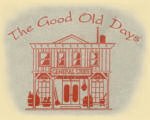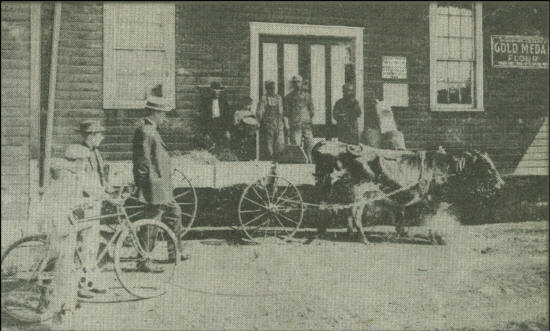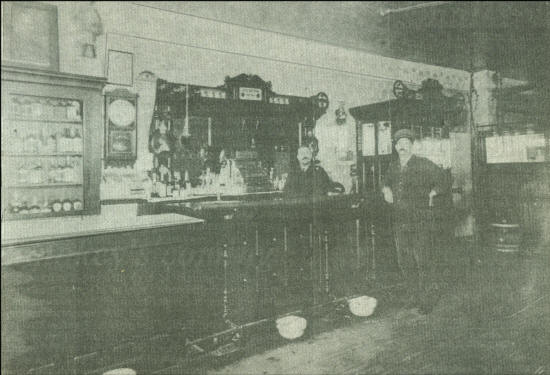|
|
 |
Clark County Press, Neillsville, WI March 29, 1995, Page 36 Transcribed by Dolores (Mohr) Kenyon. Index of "Oldies" Articles
|
|
|
 |
Clark County Press, Neillsville, WI March 29, 1995, Page 36 Transcribed by Dolores (Mohr) Kenyon. Index of "Oldies" Articles
|
Good Old Days
By Dee Zimmerman
There were about 40 heads of families who came into Clark County during the period between 1857 and 1865, and remained permanently. Others visited the vicinity, having scanned the area for possibility of a future, decided against staying and went elsewhere.
In the three years preceding the war, among those who settled at Neillsville were Chauncey Blakeslee; B. F. Chase, who studied law with Dewhurst & King; S. N. Dickenson; John Dore; William Liverman; W. B. Berry; a man named McDonald, who opened a furniture store where the Neillsville Mills was later located, along O’Neill Creek. There were probably others whose names and adventures weren’t recorded.
George Lord and L. N. Stafford first located north of Neillsville. Lord, 20 miles north and Stafford, who started Staffordville on the north side of Neillsville, purchased acreages for logging out the timber. They subsequently became residents of the village.
Some of Neillsville’s first buildings were put up by Chauncey Blakeslee, a frame structure later occupied by Gates & Co.; the house erected by James O’Neill, as a private residence; a building south of the Rossman House, later occupied by F. Klopf, was built by Anson Green for commercial purposes, and for a brief period the office of the Union Flag newspaper. W. B. Berry erected a residence west of the courthouse, where Mr. Youman resided. King and Dewhurst built residences, as did Orson Bacon.
In 1860, the village had approximately 250 residents, a weekly paper, half a dozen stores as well as lawyers and physicians. From then, to the close of he war, there was little growth or progress in the area.
Clark County’s first court house was a two-story frame building, 40’ x 50’ in dimensions. J. and T. Furlong, brothers, who were carpenters, built the structure on land donated to the village of Neillsville by James O’Neill for the cost of $1,800. That building served its purpose until 1875, when it was moved a block west on the same street. It was then occupied by a hardware store, and in its later years, was the Northern Auto Parts Store until being razed in recent years. The James Furlongs came to Neillsville in 1856.
The second court house was built starting in 1875 and completed in the spring of 1876, under the contract with C. B. Bradshaw for the amount of $35,000.
|
The second Clark County Courthouse (above) was built, starting in the fall of 1875 and completed in 1876, for the amount of $35,000, under contract with C. B. Bradshaw. The brick structure was two stories high, the roof surmounted with a cupola on which stood a statute of Justice. To the right of the courthouse, was the sheriff’s house, a two-story frame building. A brick addition on the south side of the house was the jail. When the 1897 jail was to be built, the sheriff’s house was moved to 5th and Court, northwest corner of the intersection, where it stands yet today. |
The Clark County jail was built in the summer of 1881 by James Hewett, C. Blakeslee, James O’Neill, Sr. and James Sturdevant, who as security on the bonds of County Treasurer, Allen, were compelled to make good a deficiency discovered in the funds that the official held in trust. Part of the obligation was paid, and the balance liquidated by the building of the jail and sheriff’s house. The jail, “compactly built of brick, possessed, sufficient accommodations for the times.” The sheriff’s residence was of frame structure built for the total cost of $7,000. The jail was adjacent to the sheriff’s house on the same site as the 1897 jail building. The sheriff’s house was moved to the corner of Court and 5th Street where it is yet today, offices for Concern Apartments.
The county poor house was located in the Town of York, where it was erected in 1880, by Chauncey Blakeslee, in payment of a claim, held by the county. The frame building had accommodations for 25 people, built for $7,000. With the poor-house land was a farm of 160 acres, upon which crops were to be raised, the crop sales were used as revenue for the support of the institution.
The poor house land site was dispersed of in the early 1940s, sold by the county to an area farmer.
Neillsville – March 1920: Jos. Bauer and Henry Earl assumed possession of the Batt Bakery which they bought.
Geo. Manthey bought the Star restaurant.
J. A. Hauser went to Greenwood Monday to either rent or sell his farm.
G. C. Youmans and O. E. Counsell have bought six lots adjoining the west portion, of O & N. E. Lumber yards, planning to build a large cattle barn 50 x 80 feet.
Neillsville will vote on the wet or dry proposition this spring. An internal revenue collector was in town on Monday and shut off the sale of near beer. Neillsville therefore has to vote wet this spring in order that imitation beer may be sold here.
On Sunday afternoon an ice cream social was given by Mr. and Mrs. Jos. Prock; Schafskopf, Cinch and 66 were played. A 4:30 dainty luncheon was served.
The local American Legion Post will organize a good band. About a dozen members expressed their willingness to buy instruments and learn to play.

|
The Counsell Feed & Flour Store located on Oak Street, north side of the Senior Center in Neillsville |

|
Wasserburger’s Bar |
The photo above is being re-run because of ‘wrong’ information last week. The bar was located in the Wasserburger building on West 7th Street, operated by Charles Wasserburger, standing behind the bar. His brother, John, was standing at the front of the bar. Wasserburger’s bar closed in 1918 when prohibition started. After prohibition ended, Martin Lastofski re-opened the bar which now is known as the Pink Pony. Snowball (Arthur) Meyer tended bar for him and eventually became owner of the business. Other owners were Arthur Gall, Merlin Lindow and Buck DeMert.
The Green Lantern didn’t exist until 1932, after prohibition and the sale of beer came back. Previous to that it had been a car dealership-garage owned by Bill Dahnert. Dahnert bought the bar and back bar for about $100 from a former saloon in Eau Claire. The east wall of the tavern was lined with slot machines, until slots were condemned. (Information was contributed by Ell Bollom, who came to Neillsville in 1931. Mrs. A. Meyer remembered the Pink Pony owners.)
Response from Ellen Johnson
COURT HOUSE, CLARK CO.--Our enterprising neighbors of Clark County have their Court House about completed. It is build of wood, 32 by 42 feet in size, two stories, the lower rooms eight feet and the upper rooms ten feet high. The entrance faces the West. The front hall is 10 by 30 feet, with wide stairs at either end leading to the Court Room above. From the front hall running back is a corridor 5 by 30 feet, and from this open off six rooms, three on each side, 10 by 12 feet in size, which are designed for County offices. Above there is a Court room 30 feet square, and leading from that in front over the hall is a jury room 10 by 20 feet. The building is supplied with five flues, of four of which on is set near each corner. The whole structure when finished will be an ornament to the place and an honor to the County. Cost $2,000. Jackson County Banner November 19, 1857
|
© Every submission is protected by the Digital Millennium Copyright Act of 1998.
Show your appreciation of this freely provided information by not copying it to any other site without our permission.
Become a Clark County History Buff
|
|
A site created and
maintained by the Clark County History Buffs
Webmasters: Leon Konieczny, Tanya Paschke, Janet & Stan Schwarze, James W. Sternitzky,
|